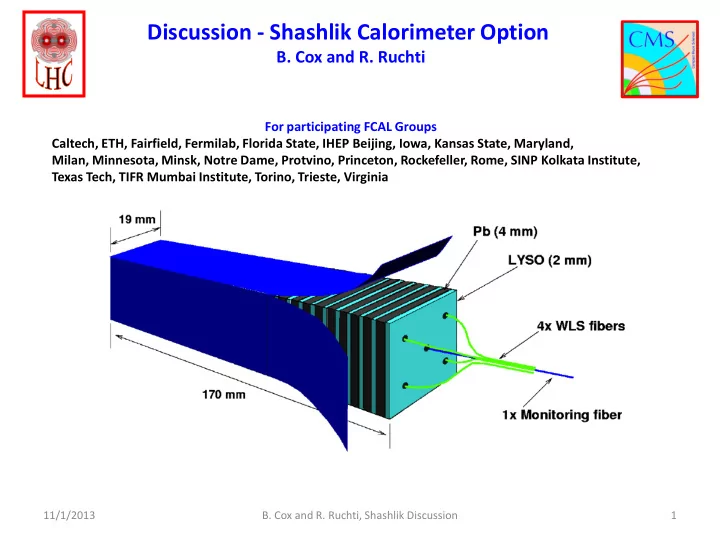

Discussion - Shashlik Calorimeter Option B. Cox and R. Ruchti For participating FCAL Groups Caltech, ETH, Fairfield, Fermilab, Florida State, IHEP Beijing, Iowa, Kansas State, Maryland, Milan, Minnesota, Minsk, Notre Dame, Protvino, Princeton, Rockefeller, Rome, SINP Kolkata Institute, Texas Tech, TIFR Mumbai Institute, Torino, Trieste, Virginia 11/1/2013 B. Cox and R. Ruchti, Shashlik Discussion 1
Discussion - Shashlik Calorimeter Option B. Cox and R. Ruchti For participating FCAL Groups Caltech, ETH, Fairfield, Fermilab, Florida State, IHEP Beijing, Iowa, Kansas State, Maryland, Milan, Minnesota, Minsk, Notre Dame, Protvino, Princeton, Rockefeller, Rome, SINP Kolkata Institute, Texas Tech, TIFR Mumbai Institute, Torino, Trieste, Virginia 14mm W (2.5mm) LYSO (1.5mm) 125mm 11/1/2013 B. Cox and R. Ruchti, Shashlik Discussion 2
Comments • Ongoing effort to set a preliminary design structure for the Shashlik in conjunction with HE replacement. The approach we are taking Reconfiguring the Shashlik to W/LYSO (rather than Pb/LYSO). This has potential cost implications that need to be considered, but benefits… • Pileup Mitigation: Reduces the solid angle per element by a factor of two. Module cross section is reduced. 19 x 19 mm2 -> 14 x 14 mm • Radiation Damage Mitigation: The module length is reduced from 17cm -> 12.5 cm. Tungsten plates 2.5mm thick vs Pb plates 4mm thick. Length reduction means shorter capillaries and hence shorter optical path. LYSO plates 1.5mm thick vs 2mm thick. Area reduction means shorter optical path in LYSO to reach capillary for WLS. Hence Benefits in both places. • To accommodate the possibility of remote placement of the photosensors, means that longitudinal space behind the Shashlik EE will need to be reserved for this (~30cm likely). This impacts the placement of the HE. • So a little more time needed to assess these impacts. • We also need to understand the segmentation of the HE. • We need to understand contributions of timing and PFLOW to the design. 11/1/2013 B. Cox and R. Ruchti, Shashlik Discussion 3
Backup Slides 11/1/2013 B. Cox and R. Ruchti, Shashlik Discussion 4
Summary from last week… Shashlik Issues to be addressed (red-high, green-moderate, blue-lower) Color code for priority wrst March decision point • Prove Capillaries are rad hard, have good light yield, and work as anticipated (R&D needed) • Prove rad hardness of GaInP and work as anticipated (R&D needed) • Pileup, how do we deal with it (simulations, R&D needed) • Transverse segmentation. Determine minimum cross sectional size for EE elements to provide e/ γ identification, γ/π 0 separation, and granularity for PF/GDE application. (simulations needed) • Longitudinal segmentation. Does this make sense for energy resolution and perhaps timing information? What do we gain for PF/GDE from such segmentation? (simulations needed) • The EE should be optimized with respect to the HE behind it for jets. (simulations needed) • How many readouts do we need per module and should it be front/back. (test beam/simulations) • Multiplexing to reduce the channel count per module. (electrical engineering needed) • Noise level from radio isotopes in Pb and LYSO; phosphorescence levels in LYSO. (R&D needed) • Neutron issues, including backsplash from Pb material as well as contributions to the overall observed pulse length. (Simulations and R&D needed) • Coverage from 1.4 < eta < 4. Can this be achieved with one set of technologies? (Simulations needed) • Other crystals to be investigated. (R&D needed) • How to do projective geometry (mechanical engineer, R&D needed). • What is the optimal mechanical construction for servicing or for module removal or replacement? (mechanical engineering needed) 11/1/2013 B. Cox and R. Ruchti, Shashlik Discussion 5
Recommend
More recommend